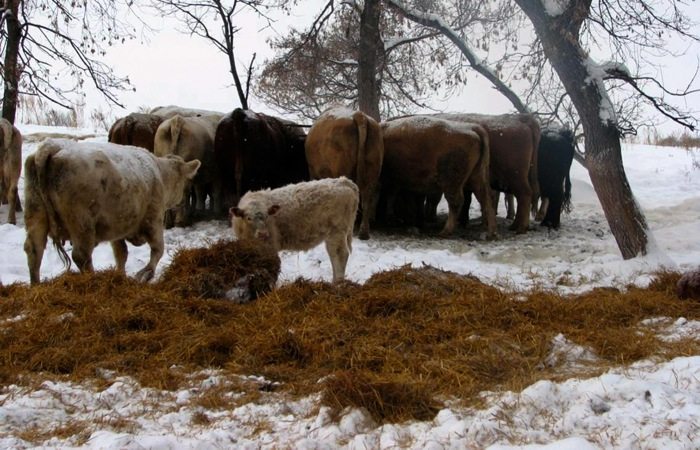
Agricultural News
How Much Hay Do I Need to Get Through Winter? Glenn Selk Helps Producers Tackle This FAQ
Mon, 11 Dec 2017 14:20:02 CST
 Dr. Glenn Selk, Oklahoma State University Emeritus Extension Animal Scientist, offers herd health advice as part of the weekly series known as the "Cow Calf Corner" published electronically by Dr. Peel and Dr. Glenn Selk. Today, Dr. Selk helps producers determine just how much hay they will need to feedout the winter.
Dr. Glenn Selk, Oklahoma State University Emeritus Extension Animal Scientist, offers herd health advice as part of the weekly series known as the "Cow Calf Corner" published electronically by Dr. Peel and Dr. Glenn Selk. Today, Dr. Selk helps producers determine just how much hay they will need to feedout the winter.
"Calculating the amount of hay that is needed on both a short term and over the course of an entire winter are mathematical exercises that are required on any cow calf enterprise. There are scientifically based 'rules-of-thumb' that can make these mathematical exercises more precise. The size of the cow, the lactation status of the cow, and the quality of the forage are key elements in determining the average daily intake of the cow. Standing forage in pastures or as crop residue can provide much of the forage needs early in the winter and when not covered by snow. As standing pasture forages diminish in both quality and quantity during the course of the winter months and most of the forage consumption comes from stored hay, then how much hay will the cow eat voluntarily? How much hay do I need to plan to feed this winter? How much hay do I need to put out for the next few days? The following forage intake table can provide a good way to estimate forage needs.
"Many grass hay samples will test 7 to 10% moisture. Therefore, when calculating daily hay intake on an 'as-fed' basis, divide the pounds of hay intake by 0.93 to 0.90 to determine actual hay intake by the cow.
"Intake in forage fed to cattle is generally limited by the forage capacity of the digestive tract. Forage intake is correlated with forage quality as shown in the table above. The more rapid rate of digestion and passage of higher quality forage results in considerably higher dry matter intake compared to lower quality forage that is lower in digestibility.
"Lactation represents the greatest need for additional energy beyond that needed for maintenance. An average milking beef cow requires 50% more TDN or energy than she does when dry. It should be noted that lactating cows consume more forage compared to gestating cows due to the increased energy demand.
"Large cows will require more energy than will small cows. Therefore the hay or forage requirements are calculated based on a percentage of the body weight of the cow. Be honest with yourself as you estimate cow size and therefore hay amounts that are needed.
"These estimates do not include hay wastage. Feeding method and hay quality will affect the percentage of the hay that is wasted. Estimates of about 6% - 11% hay wastage been reported when large round bales were fed in bale ring feeders.
"Therefore, when we evaluate the amount of hay to haul to the pastures and put in bale rings we need to make the entire calculation. Let's assume that we have an average of 1200 pound non-lactating, pregnant cows, that after calving and a short recovery will weigh 1150 pounds while lactating. The dry cow will consume 26.4 pounds/day of average quality grass hay on a 100% dry matter basis. However, the hay is actually 90% dry matter which means that the cow will consume 29.3 pounds on an 'as-fed' basis. If our hay feeding in the bale rings is very efficient and we lose only 6% as hay wastage, then we need to haul 33.98 pounds of hay per day per cow to the pasture. After these cows have calved, (using the same calculations but for lactating cows) we would need to haul 35.48 pounds per cow per day of the same hay. These calculations assume that very little, if any, standing forage is available to be consumed. Depending on quality and quantity, standing forage could reduce the hay intake significantly."
To view a Table graph with more information included in the original story, click here.
WebReadyTM Powered by WireReady® NSI
Top Agricultural News
More Headlines...





